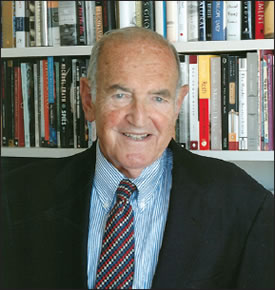In the fall of 1959, at the almost-regular meetings of the Bay Area Blood Club in San Francisco, I first met Ralph WallersteinRalph Wallerstein. I was a very new instructor in hematology at Stanford, and Ralph was arguably the leading hematologist in the Bay Area with the academic rank of clinical professor in medicine and laboratory medicine at the University of California, San Francisco (UCSF). The competition between Stanford University School of Medicine and UCSF was no secret, but perhaps it had quieted somewhat because Stanford University School of Medicine had just abandoned San Francisco to UCSF and moved onto the main Stanford University campus adjacent to Palo Alto. With that background I didn’t know what to expect from Ralph, but he was cordial, and he became my colleague, my occasional collaborator (We were among the first to identify the dwarf binucleate megakaryocyte in a patient with MDS.), and, I hope, my friend.
I had a hard time pigeonholing Ralph; I even had a hard time figuring out all the jobs he was doing. He was not a full-time academician at UCSF, but I learned that he was then chief of hematology at SF General (1952-1981) - a UCSF affiliate - and later chief of staff (1968-1972) at the Children’s Hospital. Furthermore, he was a long-time hematology consultant to the Letterman Army Hospital at the San Francisco Presidio and consultant to the VA. But the biggest surprise was to learn that his major and continuing activity was his private practice in both general internal medicine and, increasingly, hematology. On occasion we exchanged patients, and, invariably, I found that they loved him. He was a strong believer in the importance of morphology, was meticulous in reviewing the slides on all of his patients, and probably was the first to identify one of the hallmarks of chloramphenicolinduced aplastic anemia, the vacuolated normoblast. He went on to publish an important epidemiologic study focusing on the likely role of chloramphenicol in causing a very severe form of aplastic anemia.
All of these activities were essentially local, limited to the Bay Area and California. But Ralph had a drive to improve medicine on a larger scale. He became interested in ASH early on at a time when I think that ASH was struggling to find its niche. He convinced me to join, and he became ASH president in 1978. I believe he was the only ASH president who was essentially a full-time private practitioner. I was his scientific program chair and got a close-up view of how he worked. Bill Mentzer and I read all 782 abstracts and each of the two reviews that were provided by outside experts. We then met with Ralph and made our recommendations. We discovered that he had also read all of the abstracts, and we spent an entire Saturday putting the annual program together.
I think that his commitment to hematology got him interested in the American Board of Internal Medicine (ABIM), which at that point was branching out from accreditation in general internal medicine to accreditation in the subspecialties. Ralph’s work on the ABIM was so highly regarded that he was elected to the Board of Governors and then became president from 1982 to1983.
Ralph never forgot that he started practice as a general internist, and he continued to care for his earliest general medicine patients. He became increasingly involved in activities with the American College of Physicians and served as its president in 1988.
Ralph was born in Aachen, Germany, and left when the Nazis made life difficult for Jews. He was closely related to the family of Ann Frank; that branch had left Germany to live in Holland. He recalled a visit to Aachen after the war and spending the afternoon with a high school class answering the students’ many questions, including “Was he bitter?” He said that he wasn’t. I never saw any sign of bitterness. I saw a man devoted to family and to a larger view of our profession. I never understood how he did it all and so well.
Those who knew Dr. Wallerstein are invited to sign his guestbook on the ASH Web site.

